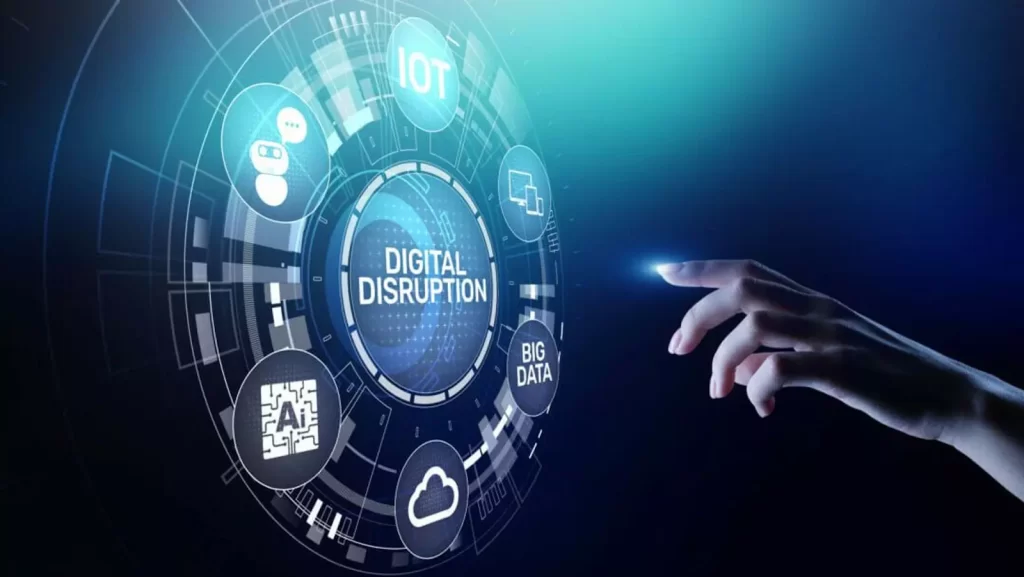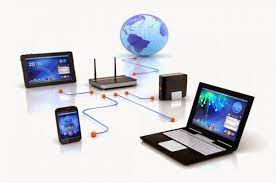Digital Disruption In the 21st century, the advent of digital technology has reshaped virtually every aspect of human life, from communication and commerce to entertainment and education. This seismic shift, often referred to as digital disruption, has revolutionized industries, challenged traditional business models, and transformed the way we live, work, and interact. Let’s delve into the phenomenon of digital disruption, exploring its causes, effects, and implications for individuals and society at large.

Understanding Digital Disruption:
Contents
- Definition: Digital disruption refers to the profound changes brought about by the rapid advancement of digital technology, particularly the internet, mobile devices, and cloud computing. It encompasses the displacement of established industries, the emergence of new business models, and the disruption of traditional ways of doing things.
- Drivers: Several factors drive digital disruption, including technological innovation, changing consumer behavior, and market dynamics. Advances in artificial intelligence, big data analytics, and the Internet of Things (IoT) have accelerated the pace of disruption, creating new opportunities and challenges for businesses and individuals alike.
Impact on Industries:
- Media and Entertainment: The media and entertainment industry has been profoundly affected by digital disruption, with traditional media outlets facing competition from online streaming services, social media platforms, and user-generated content. The shift from traditional advertising to digital marketing has also disrupted revenue models and advertising strategies.
- Retail and Commerce: Digital disruption has transformed the retail landscape, with e-commerce giants like Amazon reshaping consumer shopping habits and expectations. Brick-and-mortar retailers have had to adapt to the rise of online shopping, omnichannel retailing, and digital payment systems to remain competitive in the digital age.
Effects on Society:
- Employment: Digital disruption has had a significant impact on the labor market, leading to job displacement, automation, and the emergence of new skills and job roles. While digital technologies have created new opportunities in fields such as software development, data analysis, and digital marketing, they have also raised concerns about job insecurity and the digital divide.
- Access to Information: The proliferation of digital technologies has democratized access to information, empowering individuals to seek out news, knowledge, and resources online. However, it has also raised concerns about misinformation, echo chambers, and the spread of fake news in the digital ecosystem.
Responding to Digital Disruption:
- Innovation and Adaptation: Businesses must embrace innovation and agility to thrive in the face of digital disruption. This may involve adopting new technologies, reimagining business models, and fostering a culture of continuous learning and adaptation.
- Digital Literacy: Individuals need to develop digital literacy skills to navigate the complexities of the digital world effectively. This includes the ability to critically evaluate information, protect personal data, and harness digital tools for learning, communication, and productivity.
Digital disruption is a transformative force that has reshaped industries, economies, and societies on a global scale. While it presents challenges and uncertainties, it also offers opportunities for innovation, growth, and positive change. By understanding the drivers, effects, and implications of digital disruption, businesses, governments, and individuals can navigate the changing landscape and harness the power of digital technology to create a more inclusive, resilient, and prosperous future.
Unraveling the Pros and Cons of Digital Disruption
In today’s rapidly evolving digital landscape, the phenomenon of digital disruption has become increasingly prevalent, reshaping industries, economies, and societies worldwide. While digital disruption offers wdbos numerous advantages, it also presents challenges and drawbacks that must be carefully considered. Let’s delve into the benefits and drawbacks of digital disruption and its impact on various sectors and stakeholders.

Advantages of Digital Disruption:
- Innovation and Efficiency: Digital disruption drives innovation and efficiency by introducing new technologies, business models, and processes that streamline operations, reduce costs, and enhance productivity. Companies that embrace digital transformation can gain a competitive edge in their respective industries.
- Market Access and Globalization: Digital disrupt enables businesses to reach new markets and customers on a global scale, breaking down geographical barriers and expanding opportunities for growth and expansion. E-commerce platforms, digital marketplaces, and online advertising tools facilitate market access and international trade.
- Consumer Empowerment: Digital disruption empowers consumers by providing greater choice, transparency, and convenience in purchasing goods and services. Online reviews, comparison websites, and social media platforms enable consumers to make informed decisions and voice their opinions, shaping market trends and preferences.
- Entrepreneurship and Innovation: Digital disruptio fosters entrepreneurship and innovation by lowering barriers to entry, democratizing access to resources, and enabling rapid prototyping and iteration. Startups and small businesses can leverage digital technologies to disrupt incumbents, introduce disruptive products and services, and drive economic growth.
Disadvantages of Digital Disruption:
- Displacement and Job Losses: Digital disrupt can lead to job displacement, automation, and the restructuring of industries, resulting in layoffs, unemployment, and economic uncertainty for workers. Traditional jobs and industries may become obsolete as automation and artificial intelligence technologies replace human labor.
- Digital Divide: Digital disrupt exacerbates socioeconomic inequalities and disparities in access to technology, information, and opportunities. Communities and individuals with limited access to digital resources, such as high-speed internet, digital literacy programs, and affordable devices, are at a disadvantage in the digital economy.
- Privacy and Security Concerns: Digital disrupt raises concerns about data privacy, cybersecurity, and online threats, as individuals’ personal information becomes increasingly vulnerable to hacking, surveillance, and exploitation. Cyberattacks, data breaches, and identity theft pose significant risks to individuals, businesses, and governments.
- Regulatory Challenges: Digital disrupt challenges existing regulatory frameworks and governance structures, raising questions about accountability, consumer protection, and ethical considerations. Regulators struggle to keep pace with technological advancements and address emerging issues such as platform monopolies, algorithmic bias, and data privacy violations.
Conclusion:
Digital disruption is a double-edged sword, offering both opportunities and challenges for businesses, governments, and society as a whole. While it drives innovation, efficiency, and consumer empowerment, it also leads to job displacement, socioeconomic inequalities, privacy concerns, and regulatory challenges. By acknowledging the pros and cons of digital disrupt and adopting strategies to mitigate its negative impacts, stakeholders can harness the transformative potential of digital technology to create a more inclusive, equitable, and sustainable future.
Read More Article About “PAKORAS: ENERGIZE YOUR PALATE WITH ABSOLUTE FLAVOR“





